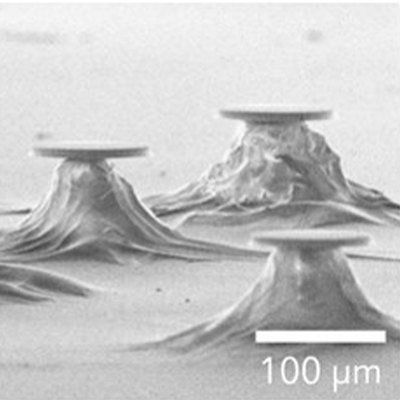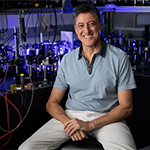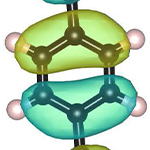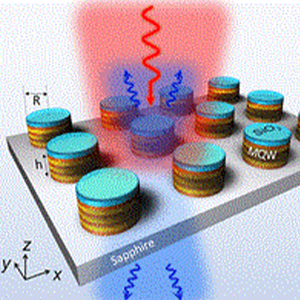
Native germanium is used to demonstrate the first high-quality micro-resonators in the long wavelength infrared (LWIR).
Chip-scale LWIR photonics has enormous potential for real-time environmental monitoring, explosive detection, and biomedicine. However, realizing technologies such as precision sensors and broadband frequency combs requires ultra low-loss and low-dispersion components, which have so far remained elusive in this regime. This work demonstrates a non-epitaxial fabrication platform for germanium micro-resonators and waveguides whose quality factors are two orders of magnitude higher than prior work. Full article here. CINT highlight slide here.

Sandia News Release — Through the quantum looking glass
A thin device triggers one of quantum mechanics’ strangest and most useful phenomena
CINT scientists and scientists at the Max Planck Institute for the Science of Light have reported on a device that could replace a roomful of equipment to link photons in a bizarre quantum effect called entanglement. This device — a kind of nano-engineered material called a metasurface — paves the way for entangling photons in complex ways that have not been possible with compact technologies. Full story here. CINT highlight slide here. Full Science article here: Resonant Metasurfaces for Generating Complex Quantum States.

On the Cover — CINT Scientists co-author article selected for front cover of Journal of Applied Physics: Interface Effect of Fe and Fe2O3 on the Distributions of Ion Induced Defects

Semi-empirical electronic Hamiltonians have nearly 30 years of successful history modeling chemistry processes such as photon absorption and chemical reactivity. However, they have always suffered from limited accuracy and generalizability due to the use of static parameters fit to limited datasets. New research from Los Alamos National Laboratory published in the Proceedings of the National Academy of Sciences uses a machine learning model to dynamically reparametrize semi-empirical Hamiltonians. Allowing physically interpretable model parameters to be adjusted according to the local chemical environment both significantly increases the model accuracy and enables new ways of interpreting results produced by machine learning models. Full story here

Extending Machine Learning beyond Interatomic Potentials for Predicting Molecular Properties
Machine learning (ML) is becoming a method of choice for modelling complex chemical processes and materials. ML provides a surrogate model trained on a reference dataset that can be used to establish a relationship between a molecular structure and its chemical properties. This Review highlights developments in the use of ML to evaluate chemical properties such as partial atomic charges, dipole moments, spin and electron densities, and chemical bonding, as well as to obtain a reduced quantum-mechanical description. We overview several modern neural network architectures, their predictive capabilities, generality and transferability, and illustrate their applicability to various chemical properties. We emphasize that learned molecular representations resemble quantum-mechanical analogues, demonstrating the ability of the models to capture the underlying physics. We also discuss how ML models can describe non-local quantum effects. Finally, we conclude by compiling a list of available ML toolboxes, summarizing the unresolved challenges and presenting an outlook for future development. Full story here

Scientific Achievement: Using four-dimensional scanning transmission electron microscopy, we demonstrate a method to visualize grains and grain boundaries in WSe2 grown by metal organic chemical vapor deposition (MOCVD) directly onto silicon dioxide. Despite the chemical purity and uniform thickness and texture of the MOCVD-grown WSe2, we observe a high density of small grains that corresponds with the overall selenium deficiency we measure through ion beam analysis. Moreover, reconstruction of grain information permits the creation of orientation maps that demonstrate the nucleation mechanism for new layers–triangular domains with the same orientation as the layer underneath induces a tensile strain increasing the lattice parameter at these sites.

An All-Dielectric Polaritonic Metasurface with a Giant Nonlinear Optical Response
Scientific Achievement: In this work, we demonstrate the possibility of enhancing the SHG efficiency of all-dielectric metasurfaces by engineering the nonlinearity of the dielectric medium that constitutes the meta-atoms. CINT highlight slide here.